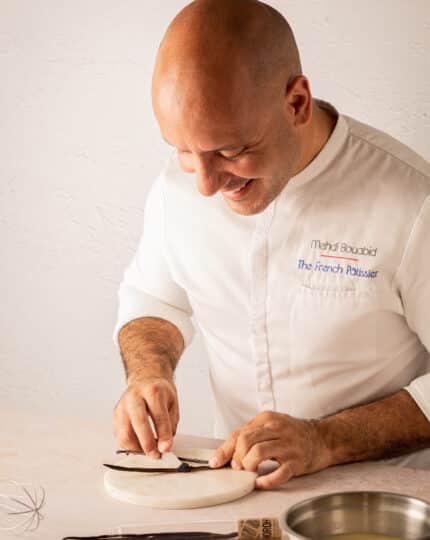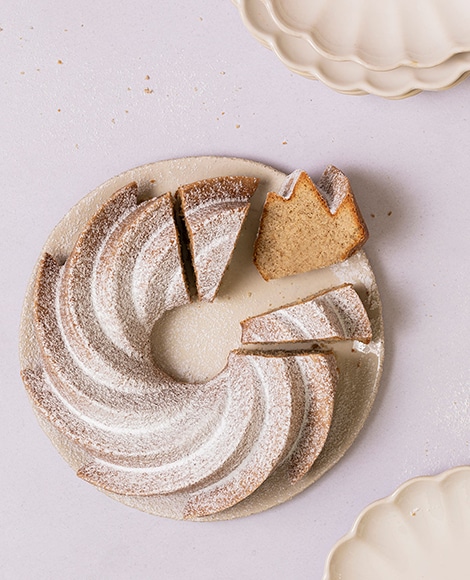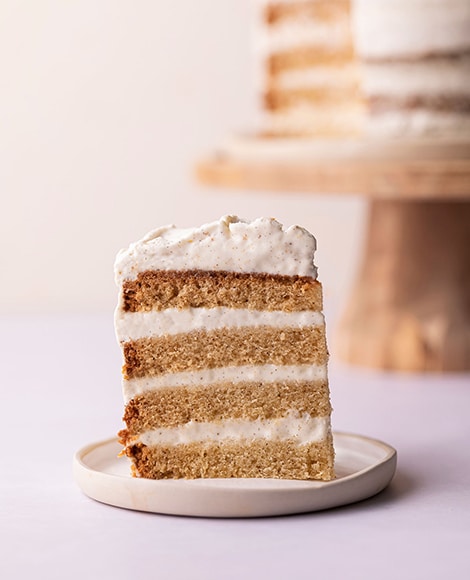SOFIA DESSERT

-
JAPANESE SPONGE
- Milk 80 g
- Butter 60 g
- Powdered vanilla 2 g
- All-purpose flour 40 g
- Almond flour 40 g
- Egg 60 g
- Egg yolks 100 g
- Egg whites 150 g
- Sugar 70 g
- Rosewater NOROHY As needed
Preheat the oven to 320°F (160°C).
Heat the butter and milk until the butter has completely
melted.
Bring the mixture to a boil.
Add the flour, almond flour, and powdered vanilla.
Pour the mixture into the bowl of a stand mixer fitted
with a paddle attachment, or into a salad bowl. Stir (with
the paddle attachment or a spatula) until the steam has
completely evaporated.
Add the eggs and yolks and mix until smooth.
Beat the egg whites until stiff, adding a third of the sugar
at a time.
Gently fold together both mixtures using a spatula until
you have a perfectly smooth sponge mix.
Pour it right to the brim of a silicone mat with a raised
edge, or onto a sheet of parchment paper to a depth of
approx. 7mm.
Bake the sponge for approx. 12/15 minutes. It should be
nicely golden and still supple.
Remove the sponge from the hot baking pan as soon as
it comes out of the oven and let it cool.
Cut it into two 14cm circles and two 6cm-wide strips.
The lengths of the 2 strips should add up to 50cm.
Steep the 2 sponge circles in rosewater. -
NAMELAKA VANILLE
- Whole milk 80 g
- Madagascan vanilla bean NOROHY 1
- Gelatin 3 g
- VALRHONA® Ivoire white chocolate 135 g
- Whipping cream (minimum 30% fat) 160 g
Melt the chocolate in the microwave or a double boiler.
Bring the milk to a boil with the split and scraped vanilla
bean.
Take it off the heat, add the bloomed and drained gelatin
and mix it in thoroughly.
Strain the mixture.
Gradually pour the mixture onto the melted Ivoire
chocolate, stirring with a spatula to give it an elastic,
glossy texture.
Add the chilled cream.
Blend using an immersion blenderPour the namelaka onto a sponge disk in a 14cm ring to
a depth of approx. 1cm. Keep the rest in the refrigerator
for decoration.
Leave to set for 2 hours in the refrigerator (this is very
important), then put it in the freezer for at least 6 hours
(until it has completely frozen) and you are ready to
assemble your dessert. -
ROSE & RASPBERRY CAVIAR (syrup)
- Water 75 g
- Sugar 25 g
.
-
ROSE & RASPBERRY CAVIAR (CAVIAR)
- Raspberry purée 160 g
- NOROHY rosewater 15 g
- Syrup 75 g
- Sugar 15 g
- Agar-agar. 2g
- Gelatin .
- Very cold flavorless oil (such as grapeseed oil) .
Bloom the gelatin.
Bring the water and sugar to a boil.
Weigh out 75g of syrup.
Add the raspberry purée.
Heat to approx. 120°F (50°C).
Mix the sugar and agar-agar and sift them into the hot
liquid.
Bring to a boil.
Off the heat, add the bloomed and drained gelatin and
the rosewater NOROHY.
Mix well.
Place the very cold oil in a measuring glass.
Put the hot liquid in a dropper and let it fall drop by drop
into the cold oil.
Use a sieve to help you retrieve the resulting caviar
pieces.
Rinse them in very cold water.
Chill the fruit caviar until you are ready to use it.
-
ROSE & RASPBERRY CONFIT
- Raspberry purée 300 g
- Sugar 30 g
- Pectin NH glaze 5 g
- Rosewater NOROHY 15 g
Mix the sugar and pectin in a bowl.
Heat the raspberry purée in a small saucepan.
When it reaches 105/120°F (40/50°C), pour the sugar
and pectin into the purée.
Mix immediately with a whisk.
Bring to a rolling boil.
Take the pan off the heat and add the rosewater.
Place the confit in a container, cover its surface with
plastic wrap, and leave to cool.
Once it has cooled, loosen it with an immersion blender
or whisk.
Pour it over the frozen namelaka to a depth of approx.3/5mm and smooth its surface.
Set it aside in the freezer for at least 4 hours (until it has
completely frozen) and until you are ready to assemble
your dessert. -
ROSE & RASPBERRY MOUSSE
- Gelatin 5g
- 100% Fruit Raspberry Purée 185g
- Whipping cream 70g
- Sugar 40g
- Water 10g
- Egg whites 30 g
Bloom the gelatin.
FOR THE WHIPPED CREAM:Beat the chilled cream using an immersion blender
fitted with a whisk attachment. It should be firm but not
overly stiff.FOR THE ITALIAN MERINGUE:
Pour the water and sugar into a small saucepan.
Cook the syrup at 244°F (118°C).
When the syrup reaches approx. 230°F (110°C), start
beating the egg whites at maximum speed using an
immersion blender fitted with a whisk attachment (the
exact timing will depend on your mixer). The egg whites
should stay very supple before the syrup is added.
When the syrup reaches 244°F (118°C), drizzle it slowly
in a thin stream onto the egg whites, reducing the
mixer’s speed to the minimum (but do not switch it off
completely). Don’t pour the syrup directly onto the whisk
or it will splash over the edges of the bowl.
Run your stand mixer at maximum speed for 2 minutes,
then at medium speed until the meringue is lukewarm
and forms stiff peaks.TO FINISH THE MOUSSE:
Melt the gelatin in the microwave with approx. 50g
raspberry purée so it reaches 120/140°F (50/60°C). Do
not bring the mixture to a boil.
Once the gelatin has melted completely, add the
remaining raspberries and whisk to combine.
Transfer the mixture into a large mixing bowl.
Add half the Italian meringue and stir it in gently with a
whisk.
Add half the whipped cream and fold it in gently with a
spatula.
Repeat with the remaining meringue, then fold in the
remaining whipped cream using a spatula.
Immediately start assembling your dessert. -
ASSEMBLY
Place a strip of acetate on a 16cm ring with a depth of
approx. 6cm.
Line the dessert with the sponge pieces so that their
more attractive side is facing outwards.
Place a circle of sponge in the base.
Add the raspberry mousse to a depth of approx. 2cm.
Add the sponge, namelaka, and confit insert.
Add some mousse to within a few millimeters of the
dessert’s edge.
Set aside in the refrigerator or freezer until the mousse
has completely set (this will take at least 4 hours).
Decorate as you wish with some dabs of namelaka,
confit, fresh raspberries, and rose and raspberry caviar.
Leave to defrost if necessary.
Remove the ring and acetate and serve
Save the recipe
If you'd like to use this recipe to enhance your rose water, you can download it here!
Download the recipe in PDFAbout the chef The French Pâtissier
The man behind The French Pâtissier is Mehdi, a Lyon native who has made his passion for pastry-making and sharing experiences with others his vocation. He is a scientist by training, and it was while doing his doctorate in astrophysics that Mehdi started making pastries and discovered his passion. Finally, he decided to swap his astrophysicist’s hat for a pastry chef’s by training in top establishments alongside renowned chefs such as Cédric Grolet, Cyril Lignac and Maxime Frédéric. Endowed with an unstoppable creativity and and driven by a determination to pass on his knowledge and start a conversation with other passionate people, Mehdi decided to create his blog, thefrenchpatissier.com, where he shares his tips and innovative creations. Since then, his career plans have grown to encompass an ambition to bring pastry to life by sharing with people and awakening their senses.



